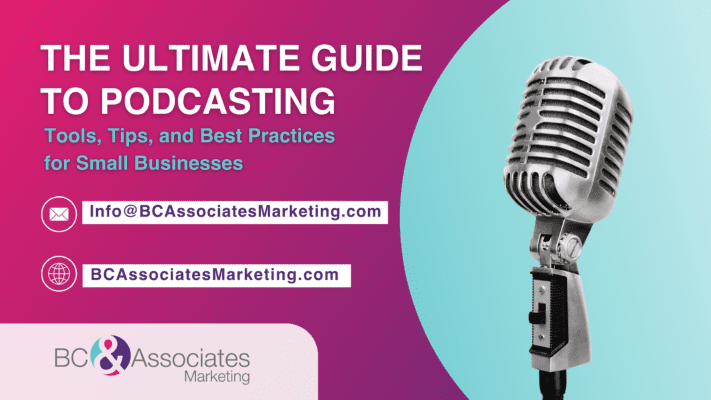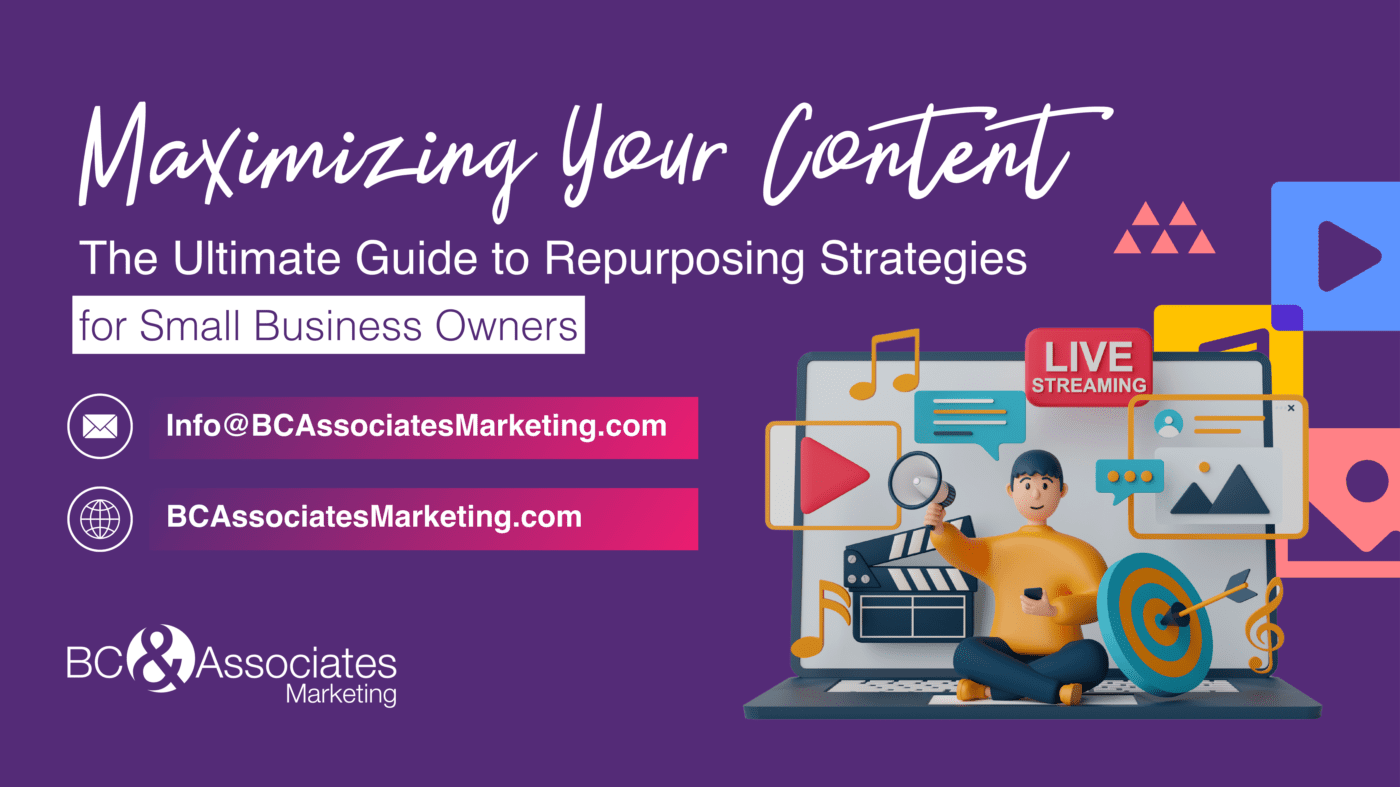In today’s fast-paced digital landscape, creating high-quality content is essential for small businesses to attract and engage their target audience. However, constantly churning out fresh content can be time-consuming and resource-intensive. The solution? Content repurposing. Small business owners can maximize their time and efforts while strategically repackaging and distributing existing content across various channels while reaching a wider audience. In this blog post, we’ll explore innovative strategies and practical tips to help small business owners create a system for effective content repurposing.
Examples of Repurposed Content
Below are a few examples demonstrating the versatility of content repurposing:
Turn Blog Posts into Social Media Graphics:
Take key points or quotes from your blog posts and turn them into visually appealing graphics for platforms like Instagram, Facebook, and Twitter. Use tools like Canva or Adobe Spark to create eye-catching graphics that highlight your content and encourage engagement. Think of carousels and multi-image posts to address all the content.
Create Video Tutorials:
If you’ve written a how-to guide or tutorial blog post, consider turning it into a video tutorial. Use screencasting software to record your screen as you walk through the steps, providing visual demonstrations that can be more engaging and easier to follow than written instructions alone.
Compile a Slide Deck:
Transform a series of blog posts or articles on a related topic into a comprehensive slide deck. Use PowerPoint or Google Slides to create visually appealing slides summarizing key points, statistics, and takeaways. Slide decks can be shared on platforms like SlideShare or used for webinars and presentations.
Publish as an E-book or Whitepaper:
Aggregate related blog posts or articles into an e-book or whitepaper that delves deeper into a specific topic. Add additional insights, case studies, and research to provide value to your audience. E-books and whitepapers can be used as lead magnets to capture email addresses or distributed as gated content on your website.
Host a Webinar or Live Stream:
Repurpose content from your blog posts or articles into a live webinar or live stream event. Use platforms like Zoom, YouTube Live, or Facebook Live to host interactive sessions where you can engage with your audience in real-time, answer questions, and provide additional insights on the topic.
Create an Infographic:
Summarize key statistics, data points, or steps from your content into an infographic. Infographics are highly shareable and visually appealing, making them ideal for social media, blog posts, or email newsletters. Use design tools like Piktochart or Venngage to create professional-looking infographics conveying visually compelling information.
Compile a Podcast Episode:
If you’ve written a series of blog posts or articles on a particular topic, consider repurposing them into a podcast episode. Record yourself or a guest discussing the content in more detail, sharing personal insights, anecdotes, and additional information that may not have been included in the written content. Podcast episodes can be shared on platforms like Spotify, Apple, or Google Podcasts, reaching a new audience and providing value in a different format. Not sure how to get started? Read our blog: The Ultimate Guide to Podcasting

Best Practices For Repurposing Content
When repurposing content, it’s crucial to adhere to certain best practices to ensure effectiveness and maintain consistency across platforms. Firstly, focus on quality over quantity, ensuring each repurposed piece maintains the same value and relevance as the original content. Secondly, tailor the format and tone of the repurposed content to suit the platform and audience, optimizing it for maximum engagement. Additionally, to cater to diverse preferences, strive for variety by repurposing content into different formats, such as infographics, videos, or podcasts. Lastly, track performance metrics to gauge the effectiveness of repurposed content and refine strategies accordingly. By following these best practices, businesses can leverage content repurposing as a powerful tool to extend reach, enhance visibility, and drive meaningful engagement.
How to Get Started Repurposing Your Content
Here are a few content repurposing strategies to get you started.
Audit Your Existing Content:
Conduct a thorough audit of your existing content assets, including blog posts, videos, podcasts, social media posts, infographics, and more. Evaluate the performance of each piece of content, identifying top-performing assets and evergreen topics that can be repurposed for future use.
Identify Repurposing Opportunities:
Once you’ve audited your content library, identify opportunities for repurposing. Look for ways to transform written content into different formats, such as videos, infographics, slideshows, podcasts, or social media posts. For example, a blog post can be repurposed into a series of social media graphics, a podcast episode, or a video tutorial.
Create a Repurposing Plan:
Develop a strategic repurposing plan outlining how to repurpose content across various channels and formats. Consider your target audience preferences, the platforms they frequent, and the types of content they engage with most. Use a content calendar to schedule repurposing tasks and ensure consistency in your content distribution efforts.
Leverage Automation Tools:
Use automation tools and software to streamline your content repurposing process. Tools like Buffer, Canva, and Adobe Spark can help you create graphics, videos, and other visual content quickly and efficiently. Social media scheduling tools like Hootsuite and Buffer can also automate the distribution of repurposed content across multiple platforms.
Optimize for SEO and Engagement:
When repurposing content, ensure it’s optimized for search engines and audience engagement. Update headlines, meta descriptions, and keywords to align with each platform’s best practices. Tailor the content format and messaging to cater to the preferences of each audience segment, maximizing engagement and interaction.
Monitor and Analyze Performance:
Track the performance of your repurposed content using analytics tools to measure its impact and effectiveness. Monitor key metrics such as website traffic, social media engagement, email open rates, and conversion rates to determine which repurposing strategies yield the best results. Use this data to refine your approach and optimize future content repurposing efforts.
Content repurposing is a game-changer for small business owners looking to maximize their time and efforts in content marketing. By creating a systematic approach to repurposing existing content assets, small businesses can reach a wider audience, drive engagement, and achieve their business goals more effectively. Use the strategies outlined in this blog post to create a robust content repurposing system that elevates your brand’s online presence and positions you for long-term success.
P.S. Ready to spark your unique opportunities and ignite your marketing? Here are three ways to work with us.
1. 📞 Schedule a Complimentary 15-minute Call and let’s delve into your goals and answer any questions you may have.
2. 📘 Read Beverly’s book Marketing for Entrepreneurs a quick guide filled with actionable steps to help make your brand and business shine even brighter. 🎙️ Listen to Beverly’s Marketing Podcast where she interviews entrepreneurs to get inspired and gain new business and marketing insights.
3. 🎓 Learn more about marketing and Enroll in Our Marketing Courses designed to bring clarity to your business efforts. They’re easy-to-understand and self-paced, perfect for busy entrepreneurs like you.


